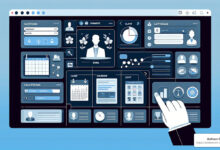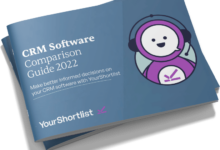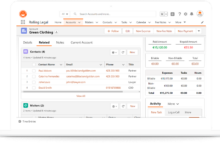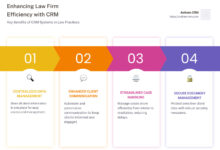Best CRM for Attorneys: Streamline Your Practice
Best CRM for attorneys isn’t just about software; it’s about transforming how you manage your practice. Finding the right CRM can significantly impact client relationships, case management efficiency, and ultimately, your firm’s success. This guide explores the key features, selection criteria, and integration capabilities of top CRMs designed specifically for the legal profession, helping you choose the perfect tool to boost your productivity and profitability.
From streamlining client communication and managing complex cases to ensuring data security and seamless integration with other legal tools, the right CRM can be a game-changer. We’ll delve into the essential features, compare leading options, and provide you with the information you need to make an informed decision that aligns with your firm’s unique needs and goals. This isn’t just about choosing software; it’s about investing in the future of your practice.
Client Communication and CRM
Effective client communication is crucial for any law firm, impacting everything from client satisfaction to case outcomes. A well-implemented CRM system acts as a central hub, streamlining communication and fostering stronger client relationships. This significantly improves efficiency and reduces the risk of missed deadlines or miscommunication.
Client communication features within a CRM drastically improve efficiency and client satisfaction. This results in better client retention and a more positive reputation for the firm.
Improved Client Satisfaction and Retention through CRM Features
CRMs offer a range of features designed to enhance client interaction. Automated email sequences can keep clients updated on case progress, while personalized communication shows you value their business. Features like integrated calendars and automated reminders ensure timely follow-ups, demonstrating professionalism and attentiveness. This proactive approach builds trust and loyalty, leading to higher client retention rates. For example, a firm using a CRM to send automated birthday greetings or anniversary messages of their initial consultation will build rapport and demonstrate personalized care that clients will remember. The ability to track client interactions and feedback allows for continuous improvement in service delivery. By analyzing this data, firms can identify areas needing improvement and proactively address client concerns, ultimately enhancing satisfaction and fostering loyalty.
Scheduling Appointments, Sending Reminders, and Managing Communication Preferences
Scheduling appointments directly within the CRM simplifies the process, eliminating the back-and-forth of emails and phone calls. Automated reminders, sent via email or SMS, reduce the likelihood of missed appointments. Furthermore, CRMs allow for the central management of client communication preferences. Clients can indicate their preferred method of contact (email, phone, text), ensuring that communication is delivered in a way that suits them best. This personalized approach shows respect for client time and preferences, contributing to a more positive client experience. For example, if a client prefers email communication, the CRM will automatically ensure all updates and reminders are sent via email, saving time and effort for both the client and the firm.
Building Stronger Client Relationships with CRM
CRMs provide a holistic view of each client, including their case history, communication logs, and preferences. This comprehensive view allows lawyers to personalize their interactions, building stronger relationships based on understanding and responsiveness. For example, remembering a client’s preferred method of communication or recalling details from a previous conversation demonstrates attentiveness and creates a more personal connection. The ability to track interactions helps identify potential issues or concerns early on, allowing for proactive intervention and conflict resolution. This proactive approach strengthens the attorney-client relationship and prevents minor issues from escalating into larger problems. By using the CRM to document all interactions, the firm maintains a clear and auditable record of its client communication, mitigating the risk of misunderstandings or disputes.
Client Communication Workflow within a CRM System
A text-based visual representation of the workflow:
“`
[Client Inquiry] –> [CRM Intake Form Completion] –> [Case Assignment & Initial Contact (Automated Email/SMS)] –> [Ongoing Communication (Email, Phone, SMS – tracked within CRM)] –> [Appointment Scheduling (CRM Calendar)] –> [Appointment Reminders (Automated)] –> [Case Updates (Automated Email/SMS)] –> [Client Feedback Collection (Surveys, etc.)] –> [Review & Analysis of Client Interactions] –> [Improved Client Service & Relationship Building]
“`
Integration with Other Legal Tools
Let’s face it: a CRM is only as good as its ability to play nicely with the rest of your legal tech stack. A siloed CRM, disconnected from your other essential software, becomes a burden, not a benefit. Seamless integration is key to maximizing efficiency and minimizing the headaches that come with juggling multiple systems.
A well-integrated CRM streamlines workflows, reduces manual data entry, and ultimately saves you and your team valuable time. This allows for a more focused approach on client matters and strategic firm growth. The benefits extend beyond simple convenience; integrated systems lead to improved accuracy, reduced errors, and a better overall client experience.
Benefits of Seamless Data Flow
Seamless data flow between a CRM and other legal software eliminates the need for repetitive data entry. Information like client details, case information, and communication history automatically updates across all platforms. This prevents inconsistencies and ensures everyone is working with the most current information. For example, if a client updates their address in the CRM, that change is instantly reflected in your document management system, avoiding potential delays or errors in correspondence. This also helps maintain data integrity, which is critical for compliance and risk management.
Examples of Integration Improving Efficiency
Imagine this: a new client signs an engagement agreement using an e-signature platform. With integration, that signed document is automatically linked to the client’s profile in your CRM, and relevant case information is automatically populated. The time saved by not manually inputting this data can be spent on higher-value tasks, such as client communication or legal research. Similarly, integrating your CRM with your billing software allows for automated invoice generation based on time entries and case milestones tracked within the CRM. This reduces billing errors and speeds up the payment process.
CRM Integration Capabilities with Popular Legal Software
Different CRMs offer varying levels of integration with popular legal software. Some CRMs boast robust APIs (Application Programming Interfaces) allowing for custom integrations with almost any system. Others offer pre-built integrations with popular platforms like Clio, PracticePanther, and NetDocuments. When evaluating CRMs, it’s crucial to assess their compatibility with your existing technology and future needs. Consider factors such as the ease of integration, the level of automation, and the support provided by the CRM vendor. A CRM with a strong API allows for greater flexibility and customization, but may require more technical expertise to set up and maintain. Pre-built integrations, on the other hand, are typically easier to implement but might offer less flexibility.
Data Flow Between CRM and Other Legal Tools
The following illustrates a simplified data flow between a CRM and other common legal tools:
[Imagine a flowchart here. The flowchart would show a central CRM box with arrows pointing to and from boxes representing other tools, such as a Document Management System (DMS), E-signature platform, and Case Management software. Arrows would indicate the flow of data, such as client information, documents, and communication logs. For example, an arrow from the CRM to the DMS would show client files being stored, while an arrow from the E-signature platform to the CRM would show signed documents being automatically linked to the client’s profile.] The flowchart visually demonstrates how data flows seamlessly between different systems, eliminating redundant data entry and ensuring consistency. This visual representation helps illustrate the efficiency gains achieved through integration.
Closure
Selecting the best CRM for your law firm is a crucial step towards optimizing your practice. By carefully considering the factors discussed – features, security, scalability, and integration – you can confidently choose a system that enhances efficiency, strengthens client relationships, and ultimately contributes to your firm’s growth and success. Remember to prioritize user-friendliness and seamless integration with existing tools for a truly impactful solution. The right CRM is more than just software; it’s a strategic investment in your firm’s future.



